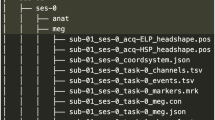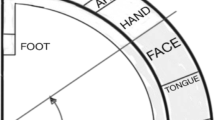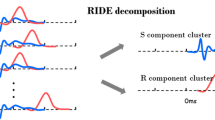Abstract
In this article we investigate MEG correlates of syntactic violations in continuous speech. An early left anterior negativity (ELAN) has been reported in previous EEG studies and has been related to syntactic processing. We used Magnetic Field Tomography (MFT) to extract a 3D estimate of the current density distribution J, from MEG data recorded while subjects listened to continuous speech. Separate estimates were obtained from the activity associated with the first word of the sentence, and the last words of the sentence which signified syntactic violation, semantic violation or correct sentences. In each case independent 3D MFT estimates of activity were obtained 2 ms apart. After converting the solutions into a PET-like format we perform a statistical analysis on a voxel-by-voxel basis. Visual inspection of the power of J at the time of the ELAN component and the statistical maps overlaid on the individual anatomical MRI suggests generators in the vicinity of the auditory cortex and in left frontal regions. Directional activation curves are computed to show the variation of activity as a function of time, from well circumscribed areas. The activation curve for the auditory cortex has a characteristic pattern consisting of three peaks, seen in the average time-locked to the onset of the first word, and the critical word of the syntactic violation. The left auditory cortex shows a delay of about 30 ms in the syntactic violation condition compared to the first word condition. No such delay is seen in the right auditory cortex.
Similar content being viewed by others
References
Demonet, J.F., Wise, R. and Frackowiak, R.S.J. Language functiones explored in normal subjects by positron emission tomography: A Critical Review. Human Brain Mapping, 1993, 1: 39–47.
Frackowiak, R.S.J. Functional mapping of verbal memory and language. TINS, 1994, 17(3): 109–115.
Friederici, A.D., Pfeifer, E. and Hahne, A. Event-related brain potentials during natural speech processing: effects of semantic, morphological and syntactic violations. Cognitive Brain Res., 1993, 1: 183–192.
Friederici, A.D. The time course of syntactic activation during language processing: a model based on neuropsychological and neurophysiological data. Brain and Language, 1995, 50: 259–281.
Friederici, A.D., Hahne, A. and Mecklinger, A. The temporal structure of syntactic parsing: Early and late ERP effects elicited by syntactic anomalies. J. Exp. Psychol.: Learn. Mem. Cogn., 1996, 5: 1–31.
Hari, R. The neuromagnetic method in the study of the human auditory cortex. In: F. Grandori, M. Hoke, G.L. Romani, (Eds.), Auditory Evoked Magnetic Fields and Electric Potentials. Adv. Audiol. Basel, Karger, 1990, vol.6: 222–282.
Ioannides, A.A., Bolton, J.P.R. and Clarke, C.J.S. Continuous probabilistic solutions to the biomagnetic inverse problem. Inverse Problems, 1990, 6: 523–542.
Ioannides, A.A. Estimates of 3D brain activity ms by ms from biomagnetic signals: method (MFT), results and their significance. In: E. Eiselt, U. Zwiener and H. Witte (Eds.), Quantitative and Topological EEG and MEG Analysis. Universitätsverlag Druckhaus-Maayer GmbH, Jena, 1995: 59–68.
Ioannides, A.A., Stephan, K.M., Fenwick, P.B.C., Lumsden, J., Fenton, G.W., Liu, M.J., Vieth, J., Squires, K.C., Lawson, D., Myers, R., Fink, G.R. and Frackowiak, R.S.J. Analysis of MEG signals from a GO/NOGO avoidance paradigm and comparison of estimates of brain activity using PET. In: C. Baumgartner, L. Deecke, G. Stroink and S.J. Williamson (Eds.), Biomagnetism: Fundamental Research and Clinical Applications; Proceedings of BIOMAG93. Elsevier, Amsterdam, 1995: 262–265.
Kaufman, L. and Williamson, S.J. Responses to steady-state auditory stimulation. In: F. Grandori, M. Hoke and G.L. Romani (Eds.), Auditory Evoked Magnetic Fields and Electric Potentials. Adv. Audiol. Basel, Karger, 1990, vol.6: 283ff.
Kutas, M. and Hillyard, S.A. Event-related potential to grammatical errors and semantic anomalies. Memory and Cognition, 1983, 11: 539–550.
McCarthy, G., Blamire, A.M., Rothman, D.L., Gruetter, R. and Shulman, R.G. Echo-planar magnetic resonance imaging studies of frontal cortex activation during word generation in humans. Proc. Natl. Acad. Sci., USA, 1993, 90: 4952–4956.
Ojemann, G.A. Brain organization for language from the perspective of electrical stimulation mapping. The Behavioral and Brain Sciences, 1983: 189–230.
Ojemann, G.A. Cortical organization of language. J. Neurosci, 1991, 11(8): 2281–2287.
Oldfield, R.C. The assessment and analysis of handedness: The Edinburgh Inventory. Neuropsychologia, 1971, 9: 97–113.
Osterhout, L. and Holcomb, P.J. Event-related potentials and language comprehension. In: M.D. Rugg and M.G. Coles (Eds.), Electrophysiology of Mind. Oxford Psychology series No.25, Oxford, 1995.
Pantev, C., Eulitz, C., Elbert, T. and Hoke, M. The auditory evoked sustained field: origin and frequency dependence. Electroencephalography and Clinical Neurophysiology, 1994, 90: 82–90.
Pelizzari, C.A., Chen, G.T.Y., Spelbring, D.R., Weichselbaum, R.R. and Chen, C.T. Accurate 3D correlation of CT, PET and/or MR images of the brain. J. Comp. Assist. Tomography, 1989, 13: 20–26.
Petersen, S.E., Fox, P.T., Posner, M.I., Mintun, M. and Raichle, M.E. Positron emission tomographic studies of the cortical anatomy of single-word processing. Nature, 1988, 331: 585–589.
Press, W., Flannery, B., Teukolsky, S. and Vetterling, W. Numerical recipes in c. Cambridge University Press, 1991.
Raichle, M.E. Exploring the mind with dynamic imaging. Seminars in the neurosciences, 1990, 2: 307–315.
Stromswold, K., Caplan, D., Alpert, N. and Rauch, S. Localization of syntactic comprehension by positron emission tomography. Brain and Language, 1996, 52: 452–473.
Strupp, J.P. Stimulate: A GUI based fMRI Analysis Software Package. Neuroimage, 1996, Volume 3,Number 3: S607.
Varnier, M. and Caplan, D. CT scan correlates of aggrammatism. In: L. Menn and L. Obler (Eds.), Agrammatic Aphasia. Amsterdam: Benjamins, 1990: 97–114.
Wise, R., Chollet, F., Hadar, U., Friston, K., Hoffner, E. and Frackowiak, R. Distribution of cortical neural networks involved in word comprehension and word retrieval. Brain, 1991, 114: 1803–1817.
Zatorre, R.J., Evans, A.C., Meyer, E. and Gjedde, A. Lateralization of phonetic and pitch discrimination in speech processing. Science, 1992, 256: 846–849.
Zurif, E., Swinney, D., Prather, P., Solomon, J. and Bushell, C. An on-line analysis of syntactic processing in Broca's and Wernicke's aphasia, Brain and Language, 1993, 45: 448–464.
Author information
Authors and Affiliations
Rights and permissions
About this article
Cite this article
Groß, J., Loannides, A.A., Dammers, J. et al. Magnetic Field Tomography Analysis of Continuous Speech. Brain Topogr 10, 273–281 (1998). https://doi.org/10.1023/A:1022223007231
Issue Date:
DOI: https://doi.org/10.1023/A:1022223007231




